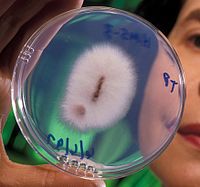
Photo from wikipedia
Pea wilt disease, caused by the soilborne and seedborne fungal pathogen Fusarium oxysporum f. sp. pisi (Fop), first appeared in Japan in 2002. We herein investigated the molecular characteristics of… Click to show full abstract
Pea wilt disease, caused by the soilborne and seedborne fungal pathogen Fusarium oxysporum f. sp. pisi (Fop), first appeared in Japan in 2002. We herein investigated the molecular characteristics of 16 Fop isolates sampled from multiple locations and at different times in Japan. The 16 isolates were divided into three clades in molecular phylogenic analyses based on both the TEF1α gene and the rDNA-IGS region. All of the Fop isolates harbored a PDA1 gene, which encodes the cytochrome P450 pisatin demethylase (Pda1), and also carried one or both of the SIX6 and SIX13 genes, which encode secreted in xylem (Six) proteins. Other forms of F. oxysporum and other species of Fusarium did not carry these sets of genes. Based on these results, a PCR method was developed to identify Fop and differentiate it from other forms and non-pathogenic isolates of Fusarium spp. We also demonstrated that the PCR method effectively detected Fop in infected pea plants and infested soils.
Journal Title: Microbes and Environments
Year Published: 2022
Link to full text (if available)
Share on Social Media: Sign Up to like & get
recommendations!